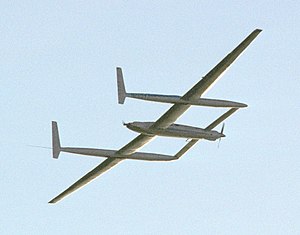Rutan Voyager
| Model 76 Voyager | |
|---|---|
 |
|
| Voyager returning from its flight | |
| Role | Record plane |
| Manufacturer | Rutan Aircraft Factory |
| Designer | Burt Rutan |
| First flight | June 22, 1984 |
| Introduction | 1984 |
| Retired | 1987 |
| Number built | 1 |
| Career | |
| Registration | N269VA |
| Preserved at | National Air and Space Museum |
The Rutan Model 76 Voyager was the first aircraft to fly around the world without stopping or refueling. It was piloted by Dick Rutan and Jeana Yeager. The flight took off from Edwards Air Force Base's 15,000 foot (4,600 m) runway in the Mojave Desert on December 14, 1986, and ended 9 days, 3 minutes and 44 seconds later on December 23, setting a flight endurance record. The aircraft flew westerly 26,366 statute miles (42,432 km; the FAI accredited distance is 40,212 km) at an average altitude of 11,000 feet (3,350 m).
The aircraft was first imagined by Jeana Yeager, Dick Rutan, and Dick's brother Burt Rutan as they were at lunch in 1981. The initial idea was first sketched out on the back of a napkin. Voyager was built in Mojave, California, over a period of five years. Voyager was built mainly by a group of volunteers working under both the Rutan Aircraft Factory and an organization set up under the name Voyager Aircraft.
The airframe, largely made of fiberglass, carbon fiber, and Kevlar, weighed 939 pounds (426 kg) when empty. With the engines included, the unladen weight of the plane was 2250 lb (1020.6 kg). However, when it was fully loaded before the historic flight, it weighed 9,694.5 pounds (4,397 kg) due to the large amount of fuel required for the long-distance flight. The aircraft had an estimated lift to drag ratio (L/D) of 27. The canard and wing airfoils were custom designed and the aircraft was analyzed using computational fluid dynamics.Vortex generators were added to the canard, to reduce sensitivity to surface contamination.
...
Wikipedia
